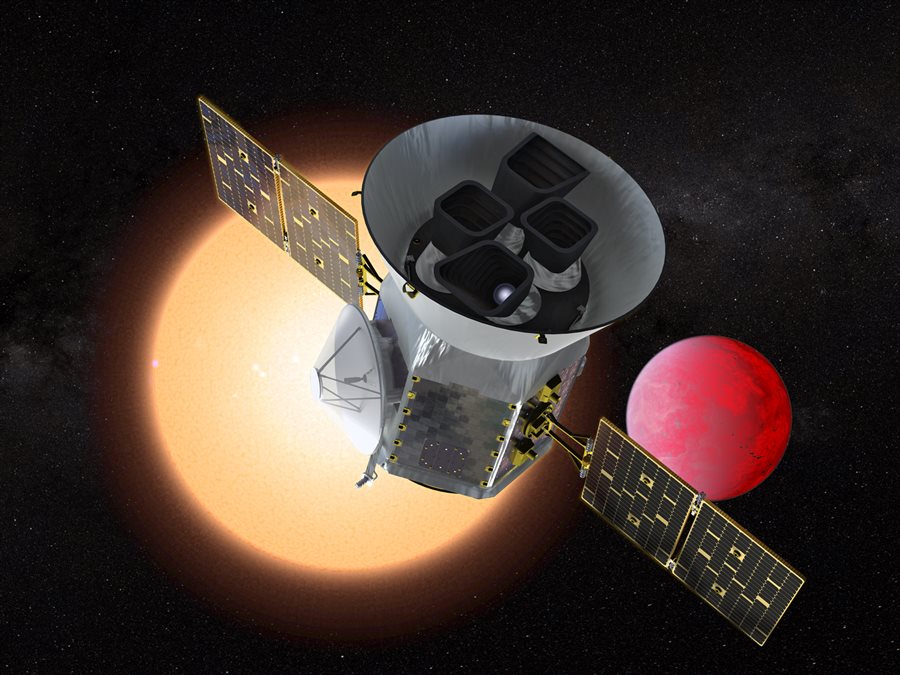Professor of Astrophysics William Chaplin explains what NASA's Transiting Exoplanet Survey Satellite (TESS) mission is, what makes the mission so exciting and the impact it will have on asteroseismology research.
 Illustration of Transiting Exoplanet Survey Satellite (TESS) surveying a star. Image credit: NASA
Illustration of Transiting Exoplanet Survey Satellite (TESS) surveying a star. Image credit: NASA
What is the TESS mission and what is its aim?
The Transiting Exoplanet Survey Satellite (TESS) is NASA’s new exoplanet and stellar astrophysics mission. It will survey the brightest stars across the sky to detect thousands of planets orbiting the stars, and to study the stars themselves. TESS will as such provide a unique census of stellar systems in the local solar neighbourhood, our own cosmological back-yard. Its nominal mission will last 2 years, with exciting opportunities for extending the mission for a further few years.
What is your role?
Astronomers at Birmingham are playing a leading role in the asteroseismology programme of TESS. Asteroseismology is the study of stars by observation of their gentle oscillations, the natural resonances of the stars (of which more below). It provides us with a unique window on the interiors of the stars and an ability to paint an exquisite portrait of the properties and characteristics of the stars, and any planets they may host.
I am one of the sevent members of the TESS Asteroseismic Science Consortium (TASC), which is overseeing the asteroseismology programme. TASC is a large international collaboration comprised of hundred scientists from around thr world. I am also co-leading the TASC studies of planet-hosting and Sun-like stars.
How will TESS work?
TESS will measure the brightness of millions of stars. It will detect planets by measuring the miniscule dimming of light from the star as any orbiting planet passes in front of the visible disc of the star, blocking some of the light we receive from it. Exactly the same data are used to detect the oscillations, and do asteroseismology. TESS will detect these gentle oscillations by observing changes in brightness as stars get slightly hotter and brighter as they are compressed and then cooler and darker as they relax.
What is the difference between TESS and the previous Kepler mission?
There are two main differences in terms of the stars observed. First, whilst Kepler has observed stars in only a fraction of the sky, TESS will look at stars across almost the entire sky. Second, TESS will observe the brightest stars in the sky. These are stars that are visible to the naked eye, and they present huge opportunities for exquisite characterisation, opening a new discovery space on stars several magnitudes brighter than the stars observed by Kepler (which were too faint to be visible with the naked eye).
How does studying stars also improve our understanding of planets?
To “know thy planet” one must “know thy star”. When a planet is discovered by the transit method the tiny dip in the amount of light received from the star provides a measure only of the size of the planet relative to the size of the star.
Thanks to asteroseismology we can measure the size of the star extremely precisely, allowing the absolute size of the planet to be fixed with a high level of confidence. We can also use this information to determine whether a planet lies in the habitable zones of the star, not too close or too far away, but just right for liquid water to potentially be present on the surface. Asteroseisomology also allows us to gather a detailed picture of the structure of stars and how planetary systems evolve over time, and whether the configuration of planets in our solar system is likely to be common or unusual.
Why is it important that we know about other Sun-like stars and their exoplanet systems?
When you look up at the sky on a clear night do you ever ask yourself: how many of the twinkling stars have planets, like the planets orbiting our own Sun? And how many of those planets may be capable of harbouring life, like the precious planet we live on? Is there some special combination of properties that a star must possess to elevate the chances of it hosting a habitable planet? Or are some Sun-like stars just too unsafe for their planets?
The discovery and characterisation of other exoplanet systems in our Galaxy allows us to address these questions and better understand our place within the Universe.
What impact will TESS have on future research?
TESS will provide a census of exoplanet systems in our local solar neighbourhood. The new exoplanetary systems it discovers that have bright host stars will also be high-priority targets for the James Webb Space Telescope (JWST), which will be launched between March and June 2019. JWST will have the ability to make exquisite characterisations of the atmospheres of the planets TESS discovers!